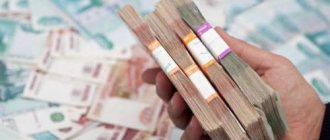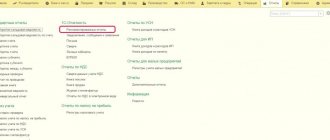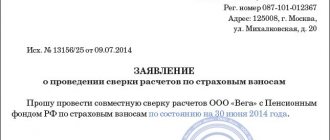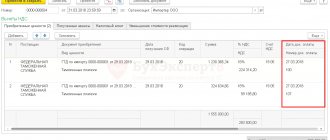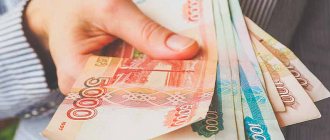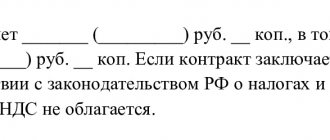Intermediary operations
Paragraph 7 of Article 149 of the Tax Code establishes that “exemption from taxation... does not apply when carrying out business activities in the interests of another person on the basis of commission agreements, commission agreements or agency agreements, unless otherwise provided by this Code.”
In other words, intermediaries selling preferential goods and services must pay VAT on remuneration in the generally established manner.
The following operations are exceptions:
- provision of premises for rent to foreign citizens or organizations accredited in Russia;
- sale of medical goods according to the list approved by the Government of the Russian Federation;
- provision of funeral services, work on the production of tombstones and the design of graves, as well as the sale of funeral supplies according to the list approved by the Government of the Russian Federation;
- sale of folk arts and crafts products of recognized artistic merit (with the exception of excisable goods), samples of which are registered in the manner established by the Government of the Russian Federation.
Thus, when selling these goods and services, both the producers themselves and the intermediaries do not pay VAT.
What is VAT?
VAT (Value Added Tax) is an indirect type of tax that is levied on a wide range of services and goods. It is calculated for the benefit of the country's budget from the surplus value. The final buyer pays tax on the entire purchase price, but the receipt of funds begins earlier, since the calculation occurs at the production stage, being added to the cost of raw materials and creation work, it is paid at all stages.
Attention
Russian legislation assumes a VAT rate of 18%, there is also a preferential rate of 10% and the possibility of a complete exemption from payment.
VAT may resemble sales or turnover tax; it is also added to the cost of goods. But unlike what was mentioned, in a situation where the buyer pays VAT, that is, buys goods whose price includes tax, the seller has the opportunity to deduct from this amount that was paid by the buyer the amount that was paid as the same tax when purchasing goods or raw materials (or using services) from a supplier. That is, the tax in practice turns out to be indirect, and it is the end consumers who pay it. In payment documents, VAT on goods appears as a separate line. This system was not developed by chance, and its use allows you to achieve several goals at once:
- Tax payment is distributed across the stages of production and commerce processes, which eliminates the cascading effect of multiple collections. This eliminates VAT overpayments, which could be very significant.
- The tax is paid by several payers, the responsibility is distributed. Evading VAT on goods using simple methods is impossible; the payment will still go to the budget - if one of the participants in the process evades it, it will still be withdrawn at subsequent stages.
- As part of the current economic situation, it removes national taxes on exports, allowing you to receive an indirect tax.
Public organizations of disabled people
This benefit is provided for in subparagraph 2 of paragraph 3 of Article 149 of the Tax Code of the Russian Federation.
The Code establishes that operations on the sale of goods (work, services) that are produced and sold by public organizations of disabled people, among whose members disabled people and their legal representatives make up at least 80%, are not subject to VAT.
Also, transactions on the sale of goods produced and sold by companies whose authorized capital consists entirely of contributions from public organizations of disabled people (provided that among the members of these organizations disabled people and their legal representatives make up at least 80%) are also not subject to VAT, if:
- the average number of disabled people among the company's employees is at least 50%;
- the share of disabled workers in the total wage fund is at least 25%.
From October 1, 2011, this benefit is also valid for state and municipal enterprises that meet the above criteria.
To determine whether a company is entitled to a benefit, it is necessary to calculate the average headcount for the quarter.
The average headcount does not include external part-time workers and persons performing work under civil contracts, if they are not on the company’s staff.
The average number of employees is determined in accordance with the procedure approved by Rosstat order No. 435 dated October 24, 2011.
If this benefit is not beneficial for you, you can refuse it.
A company cannot use the benefit if:
- The goods sold are excisable.
- The goods sold are included in the list of goods the sale of which is not subject to VAT exemption. This list was approved by Decree of the Government of the Russian Federation of November 22, 2000 No. 884.
Please note: only products produced by the company itself are not subject to VAT. For trading, brokerage and intermediary activities, it must pay VAT in the usual manner.
VAT accounting entries
Working with VAT on goods becomes the concern of an accountant, one of his most important work tasks. When working with accounting, it should be noted that according to the modern system of accounts for VAT, two points are calculated . This is account 19, which allows you to open an arbitrary number of subaccounts. This column is called VAT on acquired material assets; subaccounts can be opened at any time. The second is account 68 Calculations for taxes and fees, where it is allocated as a subaccount.
Additional Information
It is necessary to reflect and calculate VAT in accordance with all rules when selling all goods that are subject to this tax, reflecting the details using accounting tools.
Sale of medical goods and services
The sale (subclause 1, clause 2, article 149 of the Tax Code of the Russian Federation) “... of medical goods of domestic and foreign production according to the list approved by the Government of the Russian Federation” is not subject to VAT.
You will find this list in Decree of the Government of the Russian Federation dated January 17, 2002 No. 19.
Firms and individual entrepreneurs, including intermediaries who sell the goods specified in the list, can take advantage of the benefit. However, they must have a license. The benefit cannot be waived.
Firms and entrepreneurs selling medical goods not included in the list pay VAT at a rate of 18%.
VAT is also not imposed on the sale of “...medical services provided by medical organizations and (or) institutions, doctors engaged in private medical practice, with the exception of cosmetic, veterinary and sanitary-epidemiological services.”
This benefit is established by subparagraph 2 of paragraph 2 of Article 149 of the Tax Code.
However, if veterinary and sanitary-epidemiological services are financed from the budget, then they are also not subject to VAT. The benefit can be used by:
- medical organizations and institutions;
- doctors engaged in private medical practice;
- medical centers owned by non-medical companies.
A company or doctor engaged in private practice must have a license to practice medicine. Without it, the benefit cannot be applied. If you have all the necessary permits, then you are obliged to apply the benefit. Moreover, you cannot refuse it.
Please note: the services of intermediaries in the field of medical services are subject to VAT (Clause 7, Article 149 of the Tax Code of the Russian Federation).
Which goods are not subject to VAT upon import?
Tax must also be paid when importing products into the country for commercial purposes. In this sector there are also categories exempt from payment, and their full list can be seen in Art. 150 Tax Code of the Russian Federation. As an example of goods exempt from payment, one can cite technological equipment and spare parts that are not produced in Russia even within the framework of analogues. The following goods are also completely exempt from VAT when imported:
- Medicines that have no analogues, materials for their production.
- Consumables for scientific purposes that have no domestic analogues.
- Life-saving medical supplies.
- Any cultural values.
- Breeding agricultural animals, embryos.
- Items within the scope of gratuitous assistance.
- Seafood produced by domestic companies.
- Currency, securities - with the exception of collecting purposes.
- Rough diamonds.
- Objects of space activities.
- Printed products for exchange between museums and libraries.
- Goods produced by Russian companies operating abroad.
- Vessels for registration in Russia.
Educational services
Sales are not subject to VAT (clause 14, clause 2, article 149 of the Tax Code of the Russian Federation) “...services in the field of education provided by non-profit educational organizations for the implementation of general education and (or) professional educational programs (main and (or) additional), professional training programs specified in the license, or the educational process, as well as additional educational services corresponding to the level and focus of educational programs specified in the license, with the exception of consulting services, as well as services for leasing premises.”
In other words, services in the field of education are exempt from VAT only when provided in areas of basic and additional education confirmed by a license.
Also, classes with minor children in clubs, sections, studios and the maintenance of children in preschool institutions are not taxed (clause 4, clause 2, article 149 of the Tax Code of the Russian Federation).
Please note: the benefit is provided only to non-profit educational organizations.
Services in the field of education provided by commercial firms, as well as individual entrepreneurs, are taxed.
If your company provides services in the field of education and is entitled to a benefit, then you must definitely apply it. You cannot refuse the benefit.
In what cases is separate VAT accounting necessary?
Often, business entities (legal entities and individuals) in the course of their activities are faced with the need to carry out transactions both subject to VAT and, according to the terms of the law, exempt from this tax. There are also cases where one payer has two taxation regimes in effect at the same time, for example, a general system and UTII or a general system and a patent one.
For such work, separate VAT accounting is required. The absence of such a methodology does not allow the taxpayer to both take into account input VAT in relation to taxable transactions and take the amounts received to reduce the income tax base.
An economic entity retains the right to choose a specific methodology for maintaining separate VAT accounting . Current legislation does not prohibit the development and application of its own standards. But at the same time, the adopted procedure should not violate the basic principles of work, under which it is possible to reliably determine what type of operation a particular amount of input tax belongs to.
You will learn more about the principles and methods of maintaining separate accounting from the material “How is separate accounting for VAT maintained (principles and methods)?”
Distribution of input VAT by operating system in “1C: Accounting 8” (rev. 3.0)
Let's consider an example of how the 1C:Accounting 8 version 3.0 program reflects operations on the distribution of input VAT among fixed assets intended for taxable and non-VAT-taxable transactions.
Please note that in accordance with Federal Law No. 303-FZ dated 08/03/2018, VAT tax rates changed from 01/01/2019: from 18% to 20%; from 18/118 to 20/120 and from 15.25% to 16.67%.
Example
| The organization TF-Mega LLC carries out operations both subject to VAT and exempt from taxation in accordance with Article 149 of the Tax Code of the Russian Federation, as well as operations the place of implementation of which is not recognized as the territory of the Russian Federation. In addition, TF-Mega LLC sells goods from the warehouse to individuals and is a UTII payer for this type of activity. The organization TF-Mega LLC acquired:
In addition, in July 2022, the organization TF-Mega LLC:
The sequence of operations is given in Table 1. |
Setting up accounting policies, accounting parameters and directories
Due to the fact that the organization maintains separate accounting of the submitted VAT amounts when carrying out operations for the sale of goods (work, services), both subject to VAT and exempt from taxation, as well as operations the place of sale of which is not recognized as the territory of the Russian Federation, it is necessary to make the appropriate settings of accounting policies and accounting parameters.
On the VAT tab of the Accounting policy
(section
Main
- subsection
Settings
-
Taxes and reports
) you should set the flag
Separate accounting of incoming VAT
and
Separate accounting of VAT by accounting methods
.
In the accounting settings settings (section Administration - subsection Program settings - Accounting settings), by clicking on the hyperlink Setting up a chart of accounts, in the line Accounting for VAT amounts on purchased assets, set the value By counterparties, invoices received and accounting methods. To do this, you need to click on the appropriate hyperlink and check the box for the value By accounting methods.
Purchase of MFP
Receipt of a fixed asset (MFP) into an organization (operations 2.1 “Accounting for incoming MFP”; 2.2 “Accounting for input VAT”; 2.3 “Acceptance of MFP for accounting as a fixed asset”) is registered in the program by the document Receipt (act, invoice) with the type of operation Basic funds (section Purchases - subsection Purchases) or the document Receipt of fixed assets (section Fixed assets and intangible assets - subsection Receipt of fixed assets), fig. 1.
Rice. 1. Arrival of MFP
Since TF-Mega LLC carries out both taxable and non-taxable transactions, and the purchased MFP is used in the company’s office, i.e. in all ongoing operations, then in the VAT accounting method
Distributed
is indicated .
After posting the document, the following accounting entries are entered into the accounting register:
Debit 08.04.2 Credit 60.01 - for the cost of the purchased MFP;
Debit 01.01 Credit 08.04.2 - for the cost of the fixed asset accepted for accounting;
Debit 19.01 Credit 60.01 - for the amount of input VAT.
Since the amount of input VAT is subject to distribution, two entries are simultaneously entered into the VAT register submitted: one with the type of movement Receipt and the event Submitted VAT by the Supplier, the second with the type of movement Expense and the event VAT subject to distribution. At the same time, an entry is made in the Separate VAT accounting register for the amount of tax written off in the VAT
.
Register entry Separate accounting
is produced for the further distribution of the amount of input VAT, as well as for the use of data on the acquired fixed asset.
To register a received invoice (operation 2.4 “Registration of a received invoice”), you must enter the Invoice No.
and from the document
Receipt (act, invoice)
(Fig. 1), enter the number and date of the incoming invoice, respectively, and click the
Register
.
Invoice received
will be automatically created (Fig. 2), and a hyperlink to the created invoice will appear in the form of the basis document.
Rice. 2. Invoice received at the MFP
Document fields Invoice received
will be filled in automatically based on information from the document
Receipt (act, invoice)
. Besides:
- in the Received
the date of registration of the document
Receipt (act, invoice)
, which, if necessary, should be replaced with the date of actual receipt of the invoice. If an agreement has been concluded with the seller on the exchange of invoices in electronic form, then the field will indicate the date of sending the electronic invoice file by the electronic document management (EDF) operator, indicated in its confirmation; - in the line Base documents there will be a hyperlink to the corresponding receipt document;
- Operation type code
field the value 01 will be reflected, which corresponds to the acquisition of goods (work, services), property rights in accordance with the Appendix to the order of the Federal Tax Service of Russia dated March 14, 2016 No. ММВ-7-3/ [email protected] ; - The Receipt Method switch will be set to On paper
if there is no valid agreement with the seller to exchange invoices in electronic form.
If there is an agreement, then the switch will be in the position Electronically
.
Since the organization maintains separate accounting, in the Invoice document received
there is no line with the value
Reflect VAT deduction in the purchase book by date of receipt
, i.e. there is no possibility of a simplified application for input VAT deduction.
As a result of posting the document Invoice received, a registration entry is made in the Register of Invoices. Despite the fact that since 01/01/2015, taxpayers who are not intermediaries (forwarders, developers) do not keep a log of received and issued invoices, and in the document Invoice received in the Amount line it is indicated that the amounts to be recorded in the log book ( “of which by commission”) are equal to zero, the Invoice Journal register entries are used to store the necessary information about the received invoice.
Purchasing a car
Registration of a vehicle receipt operation (operations 3.1 “Accounting for an incoming vehicle”, 3.2 “Accounting for input VAT”) in the program is carried out using the document Receipt (act, invoice) with the operation type Equipment (section Purchases - subsection Purchases) or Receipt of equipment (section OS and Intangible assets - subsection Receipt of fixed assets), Fig. 3.
Rice. 3. Car arrival
Since TF-Mega LLC carries out both taxable and non-taxable transactions, and the purchased car is intended for use in all activities of the organization, then in the VAT accounting method
Distributed
is indicated .
After posting the document, the following accounting entries are entered into the accounting register:
Debit 08.04.1 Credit 60.01 - for the cost of the purchased car;
Debit 19.01 Credit 60.01 - for the amount of input VAT.
Also, if the amount of input VAT is subject to distribution, then two entries are simultaneously entered into the VAT register presented: one with the type of movement Receipt
and the event
Submitted VAT by the Supplier
, the second - with the type of movement
Expense
and the event
VAT is subject to distribution
.
At the same time, an entry is made in the Separate VAT accounting register for the amount of tax written off in the VAT
.
The Separate accounting register entry is made for the further distribution of the amount of input VAT, as well as for the use of data on the purchased asset.
To register a received invoice (operation 3.3 “Registration of a received invoice”), you must enter the Invoice No.
and from the document
Receipt (act, invoice)
(Fig. 3), enter the number and date of the incoming invoice, respectively, and click the
Register
.
Invoice received
will be automatically created (Fig. 4), and a hyperlink to the created invoice will appear in the form of the basis document.
Rice. 4. Invoice received for the car
Document fields Invoice received
will be filled in automatically based on information from the document
Receipt (act, invoice)
.
Besides:
- in the Received
the date of registration of the document
Receipt (act, invoice)
, which, if necessary, should be replaced with the date of actual receipt of the invoice. If an agreement has been concluded with the seller on the exchange of invoices in electronic form, then the date of sending the electronic invoice file by the EDF operator, indicated in its confirmation, will be entered in the field; - in the line Base documents there will be a hyperlink to the corresponding receipt document;
- Operation type code
field the value 01 will be reflected, which corresponds to the acquisition of goods (work, services), property rights in accordance with the Appendix to the order of the Federal Tax Service of Russia dated March 14, 2016 No. ММВ-7-3/ [email protected] ; - Receipt Method
switch will be set to
On paper
if there is no valid agreement with the seller to exchange invoices in electronic form.
If there is an agreement, then the switch will be in the position Electronically
.
Since the organization maintains separate accounting, in the Invoice document received
there is no line with the value
Reflect VAT deduction in the purchase book by date of receipt
, i.e. there is no possibility of a simplified application for input VAT deduction.
As a result of posting the document Invoice received
a registration entry is made in the Invoice Journal register to store the necessary information about the received invoice.
VAT distribution
According to paragraph 4 of paragraph 4 of Article 170 of the Tax Code of the Russian Federation, the amounts of VAT claimed on goods (work, services), property rights acquired both for taxable transactions and for transactions exempt from taxation are taken for deduction or taken into account in their value in that proportion , in which they are used for the production and (or) sale of goods (work, services), property rights, transactions for the sale of which are subject to taxation (exempt from taxation) - for goods (work, services), including fixed assets and intangible assets, property rights used to carry out both taxable and non-taxable (tax-exempt) transactions, in the manner established by the accounting policy adopted by the taxpayer for tax purposes, and taking into account the features established by paragraph 4.1 of Article 170 of the Tax Code of the Russian Federation.
In accordance with paragraph 4.1 of Article 170 of the Tax Code of the Russian Federation, the proportion for the distribution of the amount of claimed VAT is determined based on the cost of goods shipped (work performed, services rendered), transferred property rights, transactions for the sale of which are subject to taxation (exempt from taxation), in the total cost of goods shipped (work performed, services provided), transferred property rights for the tax period.
At the same time, for fixed assets and intangible assets purchased in the first and second months of the quarter, the taxpayer has the right to determine such a proportion based on shipment data for the corresponding month.
Despite the presence in paragraph 4 of Article 170 of the Tax Code of the Russian Federation indicating the establishment of a proportion between the cost of shipped taxable VAT and non-taxable (exempt from taxation) transactions, when forming the proportion, the amount of revenue from non-taxable transactions will also include revenue from sales transactions that are not subject to VAT. due to the fact that the territory of the Russian Federation is not recognized as the place of their sale in accordance with Article 148 of the Tax Code of the Russian Federation (letter of the Federal Tax Service of Russia dated 03/06/2008 No. 03-1-03/761, Resolution of the Presidium of the Supreme Arbitration Court of the Russian Federation dated 07/05/2011 No. 1407/11).
From 07/01/2019, for the purpose of applying paragraphs 4 and 4.1 of Article 170 of the Tax Code of the Russian Federation, operations for the sale of work (services), the place of implementation of which, in accordance with Article 148 of the Tax Code of the Russian Federation, is not recognized as the territory of the Russian Federation (except for operations provided for in Article 149 of the Tax Code of the Russian Federation), relate to transactions subject to taxation (clause “b”, paragraph 3, article 1 of Law No. 63-FZ).
Automatic distribution of the amount of input VAT (operations 4.1 “Distribution of VAT on MFIs by accounting methods”; 4.2 “Distribution of VAT on a car by accounting methods”; 4.3 “Accounting for VAT on a car in the cost of a non-current asset”; 4.4 “Accounting for VAT on MFIs in the cost of a non-current asset” asset"; 4.5 "Accounting for VAT on MFIs in the cost of fixed assets") is carried out by the regulatory document Distribution of VAT
(section
Operations
- subsection
Period closure
).
The distribution of the presented VAT amount is carried out according to those fixed assets, upon acquisition of which the value Distributed is specified in the VAT accounting method (MFP and car)
.
According to established arbitration practice and clarifications of the Federal Tax Service of Russia and the Ministry of Finance of Russia, when purchasing fixed assets, the buyer has the right to claim a tax deduction of the presented amount of VAT in full within 3 years from the date of acceptance of the fixed assets for registration, including in account 08 “Investments in non-current assets "(Clause 1, 1.1 of Article 172 of the Tax Code of the Russian Federation, letters of the Ministry of Finance of Russia dated 09/04/2018 No. 03-07-11/63070, dated 12/19/2017 No. 03-07-11/84699, dated 04/11/2017 No. 03-07 -11/21548).
Consequently, input VAT on all acquired fixed assets, both accepted for accounting on account 01 (MFP) and accepted for accounting on account 08 (car), is subject to distribution in the month of acquisition.
Since fixed assets were purchased in July 2022 and the proportion of VAT distribution will be formed based on shipment data for the corresponding month, then in the VAT Distribution
the date must be set to 07/31/2019.
To calculate the proportion of VAT distribution, you must execute the Fill
.
After executing this command on the Sales Revenue tab, the following will be automatically calculated:
- the amount of revenue (the cost of shipped goods (work, services, property rights)) from activities subject to VAT (including the amount of revenue from the sale of non-commodity goods for export and the amount of revenue from the sale of services, the place of sale of which is not recognized as the territory of the Russian Federation according to Article 148 of the Tax Code of the Russian Federation, i.e. services not on the territory of the Russian Federation);
- the amount of revenue from activities not subject to VAT (not UTII);
- the amount of revenue from activities not subject to VAT (UTII);
- the amount of revenue from sales subject to VAT at a rate of 0% (except for the export of non-commodity goods).
Thus, the proportion indicators for the distribution of VAT for July 2022 will be:
- revenue from taxable activities (cost of shipped goods, works, services, property rights) for July 2022 excluding VAT - RUB 672,600.00. (RUB 600,000.00 (sale of goods subject to VAT at a rate of 20%, excluding VAT) + RUB 72,600.00 (provision of advertising services to a foreign person));
- revenue from activities not subject to VAT (not UTII) - RUB 19,200.00. (transfer of goods for advertising purposes);
- revenue from activities not subject to VAT (UTII) - RUB 350,000.00.
In addition, it should be noted that when carrying out activities taxed in accordance with different regimes (general tax regime and UTII), and distributing costs between these types of activities, the share of VAT included in the cost of purchased goods (works, services) is taken into account accordingly. . To do this, in the Article fields to include VAT in the costs of activities
should be indicated (Fig. 5):
- in the field not subject to VAT (not UTII) - the value Write-off of VAT on expenses (For activities with the main taxation system);
- in the non-taxable VAT (UTII) field - the value Write off VAT on expenses
(
For certain types of activities with a special taxation procedure
).
Rice. 5. Calculation of the proportion for the distribution of VAT
Automatic distribution of the input VAT amount will be reflected on the Distribution
document
Distribution of VAT
.
According to the calculated proportion:
- the share of VAT accepted for tax deduction will be 64.56134% (RUB 672,600.00 / (RUB 672,600.00 + RUB 19,200.00 + RUB 350,000.00) x 100%), which according to MFP it corresponds to 22,928.96 rubles. (RUB 35,515.00 x 64.56134%);
- the share of VAT included in the cost of acquisitions will be 35.43866% ((RUB 19,200.00 + RUB 350,000.00) / (RUB 672,600.00 + RUB 19,200.00 + 350,000.00 rub.) x 100%), which according to MFP corresponds to 12,586.04 rubles. (RUB 35,515.00 x 35.43866%).
The amount of input VAT to be included in the cost of acquisitions will be additionally distributed between types of activities (general taxation system and UTII).
Since the car was accepted for accounting (on account 08) also in July 2022, the distribution of VAT on it should be made in the same way as the distribution of input VAT for MFIs.
| 1C:ITS For more details, see the explanations of O.S. Duminskaya, Advisor to the State Civil Service of the Russian Federation, 2nd class of the Value Added Tax Department of the Department of Taxation of Legal Entities of the Federal Tax Service of Russia, in the section “Consultations on Legislation” and in the article “Distribution of Input VAT on Fixed Assets”. |
If the transaction for purchasing a car was not automatically reflected on the Distribution tab of the VAT Distribution document, then you need to click on the Add button to enter information in the tabular section by filling out the following columns: Invoice, Total, Type of value, VAT account, % VAT, Batch, Cost account , Subconto.
To distribute the reflected amount of VAT (to fill out the columns: Accepted for deduction, Taken into account in the cost, Taken into account in the cost (UTII)), you must click on the Distribute button (Fig. 6).
Rice. 6. Distribution of input VAT by MFP and vehicle
According to the calculated proportion for the car:
- the share of VAT accepted for deduction will be RUB 127,831.45. (RUB 198,000.00 x 64.56134%);
- the share of VAT included in the cost of acquisitions will be RUB 70,168.55. (RUB 198,000.00 x 35.43866%).
After posting the VAT Distribution document, the following entries will be made in the accounting register:
- the amounts of input VAT on the purchased MFP and car will be transferred from the credit of account 19.01 with the third sub-account. Distributed to the debit of account 19.01 with the third sub-account. Accepted for deduction
and
taken into account in the cost
in accordance with the calculated proportion; - the amount of input VAT to be included in the cost of the car will be written off from the credit of account 19.01 with the third sub-account Included in the cost in the debit of account 08.04.1;
- the amount of input VAT to be included in the cost of the MFP will be written off from the credit of account 19.01 with the third sub-account. Taken into account in the cost
in the debit of account 08.04.2 with a subsequent write-off to the debit of account 01.01.
Receipt will be entered into the VAT register presented
with the event, VAT is distributed to the amount of VAT presented by the supplier and subject to deduction after distribution.
VAT-exempt transactions
register will record the amount of VAT that is not accepted for tax deduction and relates to activities with the main tax system.
in the Separate VAT accounting
:
- with the type of movement Expense
- for the VAT amounts presented by the supplier and subject to inclusion in the cost of acquisitions after distribution; - with the type of movement Receipt
- for the VAT amounts presented by the supplier on acquired fixed assets, taken into account at the time of distribution as part of non-current assets (on account 08).
How to count
Calculate your share of expenses using the following formula:
If this rule is observed and the result obtained does not exceed 5%, then the input tax on total costs can be deducted in full without distribution.
To recap what constitutes total expenses, the five percent rule. Such costs include expenses for the acquisition of goods or their production or sale, as well as for the purchase of works, services or property rights that will be used in carrying out both non-taxable and taxable transactions.
Please note that the procedure for distributing total costs is not fixed in the Tax Code of the Russian Federation. This means that each economic entity independently determines the order of distribution of this category of costs. This decision must be fixed in your accounting policies.
Conditions for VAT exemption
There are a number of conditions, if one of which is met, an organization or entrepreneur has the right to relieve itself of the obligation to pay tax for a period not exceeding one year:
- Confirm the right to use special regimes;
- Confirm the status of a participant in the Skolkovo innovation cluster;
- Provide the relevant service with confirmation of the amount of revenue for three calendar months not exceeding 2 million rubles;
- Confirm activities that are subject to tax exemption legislation.
At the same time, we must not forget that each of these conditions has a number of restrictions, which are described in detail in the code.
